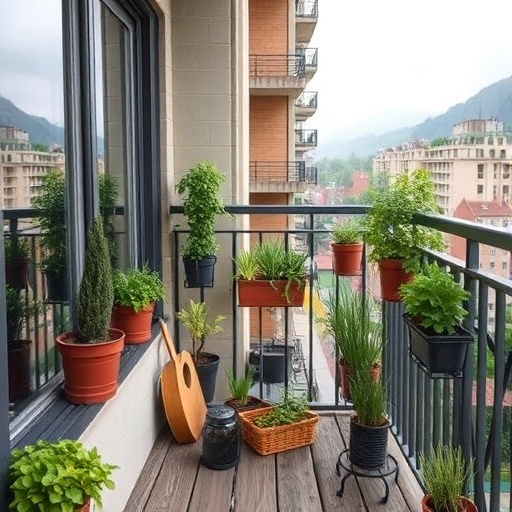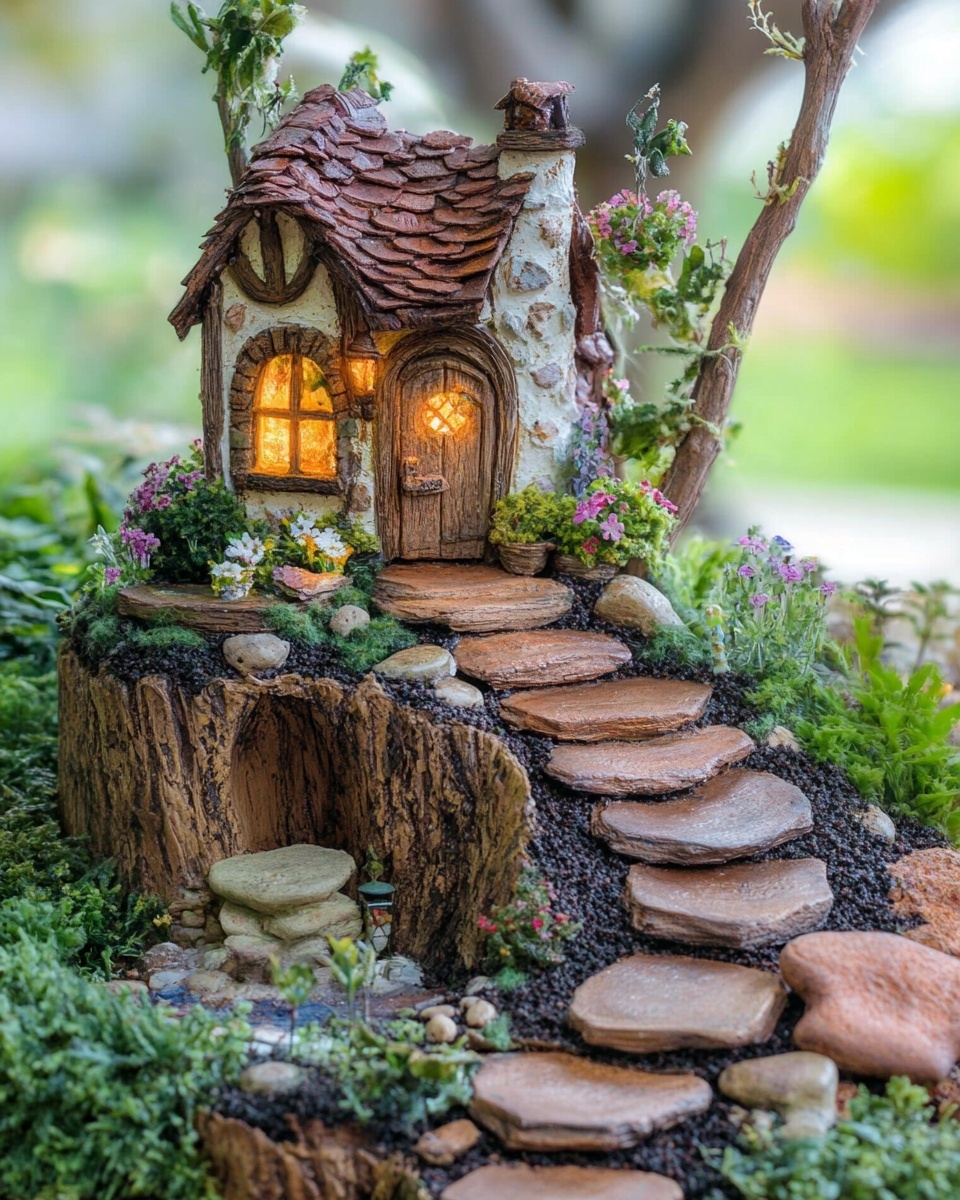Introduction
Have you ever wondered if you truly need a sprawling backyard to cultivate a thriving garden? Many aspiring green thumbs believe that limited space is a barrier to the joys of homegrown freshness. This couldn’t be further from the truth! With just a sunny balcony and a passion for growth, anyone can embark on the rewarding journey of gardening for beginners. This comprehensive guide will equip you with the knowledge and inspiration to transform even the smallest outdoor nooks into vibrant, productive herb havens, turning your urban living into an oasis of fresh flavors and aromatic delights. Let’s dig in!
Tools & Materials Needed
Embarking on your balcony herb garden adventure starts with gathering the essentials. Don’t worry, you won’t need a heavy-duty shed full of expensive equipment. Most items are readily available and many offer eco-friendly alternatives.
- Pots and Planters: Variety is the spice of life, and also of a good herb garden! Choose pots with drainage holes – this is non-negotiable for healthy roots. Terracotta pots look classic and allow roots to breathe, while plastic pots retain moisture longer. For a budget-friendly and sustainable approach, consider repurposing old containers like tin cans (ensure you make drainage holes), plastic bottles, or even sturdy food packaging. Vertical planters or hanging baskets are excellent for maximizing space on smaller balconies.
- Good Quality Potting Mix: This is the foundation of your garden’s success. Don’t skimp here! A good organic potting mix provides essential nutrients and ensures proper drainage. Look for mixes specifically designed for containers, as they are lighter and retain moisture better than garden soil. Avoid using soil directly from your yard, as it can be too dense and may contain pests or diseases.
- Herb Seeds or Seedlings: For instant gratification, start with healthy seedlings from a local nursery. If you enjoy the process of watching life emerge, seeds are a cost-effective alternative. Popular beginner-friendly herbs include basil, mint, parsley, chives, thyme, rosemary, and oregano.
- Small Hand Trowel and Cultivator: These are your primary digging and loosening tools. A comfortable grip makes all the difference.
- Watering Can with a Fine Rose: Gentle watering is key, especially for delicate seedlings. A fine spray prevents soil erosion and over-watering.
- Gardening Gloves: Protect your hands from dirt, thorns, and potential irritants.
- Pruning Shears or Scissors: Essential for harvesting herbs and encouraging bushier growth.
- Labels or Markers: Keep track of what you’ve planted, especially if starting from seeds. Wooden craft sticks or repurposed plastic tags work well.
- Optional – Organic Fertilizer: A slow-release organic granular fertilizer or a liquid feed can boost plant health, particularly for hungry herbs like basil or mint. Composted kitchen scraps also make excellent nutrient boosters.
- Optional – Pest Control: Neem oil, diluted soapy water, or companion planting strategies can help deter common pests naturally.
Time & Effort Overview
One of the most appealing aspects of gardening for beginners is its flexibility. A small balcony herb garden doesn’t demand huge chunks of your time, making it perfect for busy schedules.
- Initial Setup (Planting): Expect to spend about 1-2 hours for the initial planting session, depending on the number of herbs and whether you’re starting from seeds or seedlings. If you are starting from seeds, allow for an additional 15-30 minutes for careful seed placement.
- Daily Maintenance: This is usually quick – around 5-10 minutes for a quick check on moisture levels, light pruning, or pest inspection.
- Weekly Maintenance: A more thorough check, including deeper watering, light feeding, and harvesting, might take 15-30 minutes.
- Monthly Maintenance: Repotting, significant pruning, or addressing any larger pest issues could take 30-60 minutes.
Compared to a full-sized vegetable garden, a balcony herb garden is significantly less demanding. For example, growing a tomato plant from seed to harvest might require daily attention for staking, pruning, and pest management, totaling several hours a week. Herbs, however, are generally low-maintenance, thriving with consistent, yet minimal, care.
Difficulty Level: This project is firmly in the beginner category. Herbs are resilient and forgiving, offering a fantastic entry point into the world of gardening. You’ll gain confidence and practical skills without feeling overwhelmed.
Step-by-Step Gardening Process
Ready to get your hands dirty? Follow these clear steps to establish your flourishing balcony herb garden.
Preparing Your Space
First, ensure your balcony is clean and safe. Sweep away debris and assess sunlight exposure throughout the day. Most herbs thrive with at least 4-6 hours of direct sunlight. Identify the sunniest spot for your sun-loving herbs like basil and rosemary, and a slightly shadier spot for those that prefer less intense light, such as mint or parsley.
Choosing Your Containers
Select pots that are appropriate for the size of your mature herb. Deeper pots are better for herbs with extensive root systems, like rosemary or mint. Ensure every pot has adequate drainage holes at the bottom to prevent waterlogging. If a pot lacks holes, drill a few yourself or line the bottom with a layer of gravel before adding soil, though drainage holes are always preferable.
Adding Potting Mix
Fill your chosen pots with a high-quality, well-draining potting mix. Leave about an inch or two of space from the rim to allow for watering without overflow. Gently pat the soil to remove large air pockets, but avoid compacting it too much, as roots need space to breathe.
Planting Seeds or Seedlings
If planting seeds, follow the package instructions for depth and spacing. Generally, small seeds are sown shallowly and lightly covered with soil. For seedlings, carefully remove them from their nursery pots, gently loosen any circling roots, and place them in the prepared hole. Ensure the top of the root ball is level with the surrounding soil. Firm the soil gently around the base of the plant.
Watering After Planting
Immediately after planting, give your herbs a good drink of water. This helps settle the soil around the roots and provides essential hydration. Water until you see excess water draining from the bottom of the pot.
Initial Pruning and Care
If you’ve planted seedlings, you might notice some leggy or damaged leaves. Gently snip these off. For herbs like basil, pinching off the top center leaves can encourage bushier growth from the start. Throughout their growth, regular harvesting acts as a form of pruning, promoting more abundant yields.
Labeling Your Herbs
Don’t underestimate the importance of labels! It’s easy to forget what you’ve planted, especially with similar-looking seedlings. Use waterproof markers on your labels so they don’t fade in the sun and rain. A clear label helps you track growth and care needs for each specific herb.
Growth & Care Tips
Consistent, thoughtful care is the secret to a continuously bountiful herb garden.
- Watering Frequency: This is perhaps the most crucial aspect of herb care. Most herbs prefer consistently moist, but not soggy, soil. A good rule of thumb is to check the soil moisture daily by sticking your finger about an inch or two into the soil. If it feels dry, it’s time to water. However, some herbs like rosemary and thyme prefer slightly drier conditions, while mint and basil are thirstier. Overwatering is a common killer for balcony plants, as excess water has nowhere to go. Always ensure proper drainage. For more insights into optimal watering, check out this guide: How to Water Balcony Herbs Without Overwatering.
- Sunlight Exposure: As mentioned, most herbs require 4-6 hours of direct sunlight daily for optimal growth. Place sun-lovers like basil, oregano, and rosemary in your sunniest spots. Herbs like parsley, mint, and cilantro can tolerate partial shade, especially during the hottest parts of the day. Did you know that studies show plants grown with adequate sunlight can produce up to 25% more essential oils, enhancing their flavor and aroma?
- Pruning for Bushier Growth: Regular pruning encourages your herbs to produce more leaves and prevents them from becoming leggy or going to seed too quickly. For most herbs, simply pinch off the top few sets of leaves, just above a leaf node. For flowering herbs like basil or mint, pinch off flower buds as soon as they appear to redirect the plant’s energy into leaf production instead of seed production.
- Fertilization: While a good potting mix comes with initial nutrients, your herbs will eventually deplete them. About 4-6 weeks after planting, begin feeding with a diluted liquid organic fertilizer every 2-4 weeks. Worm castings or compost tea are fantastic natural alternatives that enrich the soil microbiome.
- Pest Prevention: Vigilance is key! Inspect your plants regularly for any signs of pests like aphids, spider mites, or whiteflies. Early detection makes prevention easier. A simple solution of diluted neem oil or insecticidal soap can effectively manage most common pests. Companion planting, such as placing marigolds near your herbs, can also naturally deter unwanted visitors. Healthy plants are naturally more resistant to pests.
Eco-Friendly & Sustainable Alternatives
Cultivating a balcony garden is an inherently rewarding and sustainable activity. Enhance its eco-friendliness with these practices:
- Composting: Start a small-scale composting system for your kitchen scraps and garden trimmings. A vermicompost bin (worm bin) is perfect for apartment living and produces nutrient-rich “black gold” for your plants. This significantly reduces waste and provides free, organic fertilizer.
- Natural Fertilizers: Beyond your homemade compost, consider using coffee grounds (acid-loving plants appreciate these), eggshells (for calcium), or banana peels (for potassium) directly in your soil. These natural amendments reduce reliance on synthetic fertilizers, which can have an environmental impact.
- Water Conservation: Implement smart watering techniques. Use watering cans instead of hoses to minimize runoff. Consider self-watering planters or add a layer of mulch (like wood chips or shredded leaves) to the top of your soil to reduce evaporation. Explore tips on preventing overwatering and optimizing your watering schedule for your specific setup: How to Water Balcony Herbs Without Overwatering.
- Repurposing Materials: One of the most enjoyable aspects of sustainable gardening is finding new uses for old items. Yogurt containers, milk jugs, tin cans, and old tires can become functional and charming planters. Just remember to add drainage holes! See how others have embraced this concept: DIY Balcony Herb Garden with Recycled Containers.
- Vertical Gardening: Maximizing your space means more plants in a smaller footprint. Vertical gardens, hanging planters, and tiered shelves are ingenious solutions for compact balconies. This approach not only looks fantastic but also utilizes space efficiently. Discover creative vertical solutions here: Vertical Balcony Herb Garden Design Ideas.
Creative Ideas & Uses
Beyond providing fresh ingredients, your balcony herb garden can be a source of beauty and inspiration.
- Aesthetic Groupings: Think about varying heights, textures, and colors when arranging your herbs. Taller rosemary can be a backdrop for bushy basil and trailing thyme. Consider decorative rocks or small garden ornaments to add visual interest.
- Companion Planting for Beauty and Benefit: Grouping certain herbs can not only look lovely but also offer mutual benefits. For example, basil is said to deter flies and mosquitos, while marigolds can keep nematodes away from delicate roots.
- DIY Planter Decorations: Personalize your pots! Paint terracotta pots, stencil designs on plastic containers, or wrap them in decorative twine. This adds a unique touch to your urban oasis.
- Herb Spirals: Even on a balcony, you can create a mini herb spiral using stacked stones or bricks. This clever design maximizes sun exposure and accommodates different drainage needs within a small footprint.
- Integrated Seating: Design your balcony garden around a small bistro set or folding chair. Imagine sipping your morning coffee surrounded by the calming aroma of fresh herbs – it transforms your balcony into an inviting outdoor room.
- Edible Landscaping: Your herbs aren’t just for cooking! Use mint and lemon balm to garnish drinks, basil for pestos, chives in omelets, and rosemary to infuse olive oil. The beauty of a balcony herb garden is that it’s both functional and decorative.
For more layout inspiration, including ideas for maximizing compact spaces, check out this resource: Compact Balcony Herb Garden Layout Plan. Don’t forget that even those herbs you grow indoors can be easily transitioned to your balcony for more light and air: How to Grow Herbs Indoors: Move Them to Balcony.
Common Mistakes to Avoid
Even seasoned gardeners make mistakes, but knowing common pitfalls can spare you grief in your gardening for beginners journey.
- Overwatering: This is arguably the number one killer of potted plants. Constantly soggy soil suffocates roots, leading to rot and plant death. Remember: it’s better to slightly under-water than to over-water. “When in doubt, don’t water,” is a good mantra for new gardeners. Proper drainage is your best friend.
- Underestimating Sun Needs: While some herbs tolerate partial shade, most robustly flavorful herbs like basil, rosemary, and oregano thrive in full sun (6+ hours daily). Insufficient light leads to leggy, weak plants with diminished flavor. Observe your balcony’s sun patterns throughout the day.
- Ignoring Drainage Holes: Placing plants in pots without drainage holes is a recipe for disaster. Standing water at the bottom of the pot creates an anaerobic environment where roots cannot breathe and quickly rot. Always ensure your containers have multiple drainage holes.
- Using Garden Soil in Pots: Garden soil is heavy and compacts easily in containers, restricting root growth and drainage. Potting mix is formulated to be lighter, airier, and retain moisture appropriately for container gardening.
- Planting Too Closely: While tempting to squeeze many plants into one pot, overcrowding leads to competition for nutrients, water, and light. It also reduces air circulation, making plants more susceptible to fungal diseases and pests. Give each herb enough space to grow to its mature size.
- Neglecting Pests Early On: A small pest problem can quickly escalate. Regularly inspecting your plants (under leaves, too!) allows you to catch and address issues before they become a full-blown infestation. Organic solutions are often effective if applied early.
- Not Harvesting Regularly: Many herbs, especially leafy ones like basil and parsley, benefit from frequent harvesting. This encourages the plant to produce more foliage and prevents it from ‘bolting’ (going to seed), which can decrease flavor and end the plant’s life cycle prematurely.
Maintenance & Storage Tips
Ensuring the longevity and productivity of your balcony herb garden involves ongoing care and smart harvesting practices.
- Long-Term Plant Health:
- Repotting: As your herbs grow, they may outgrow their containers. When roots start to emerge from drainage holes or growth slows, it’s time to move them to a slightly larger pot with fresh potting mix. This typically happens every 1-2 years for perennial herbs.
- Seasonal Care: For perennial herbs like rosemary, thyme, or oregano, consider bringing them indoors or providing winter protection if you live in a cold climate. Move pots closer to a wall or wrap them in burlap to insulate them against harsh frosts.
- Soil Amendment: Even without repotting, topping off your pots with fresh compost or worm castings annually will replenish nutrients and improve soil structure.
- Harvesting and Storage:
- How to Harvest: Always use clean scissors or pruning shears. For most herbs, harvest the newer growth from the top, just above a leaf node. This encourages bushier growth. Avoid taking more than a third of the plant at once to ensure it can recover and continue producing.
- Fresh Storage: Many herbs (parsley, cilantro, basil) can be stored by placing their stems in a glass of water on your counter or in the fridge, much like flowers. Cover loosely with a plastic bag.
- Drying Herbs: Hang bundles of tougher herbs like rosemary, thyme, and oregano upside down in a cool, dark, well-ventilated area until crisp. Store dried herbs in airtight containers away from direct sunlight.
- Freezing Herbs: Freezing is excellent for preserving the flavor of delicate herbs like basil or cilantro. Chop them and freeze in ice cube trays with a little olive oil or water. Once frozen, transfer the cubes to a freezer bag.
- Solutions for Common Issues:
- Yellow Leaves: Often a sign of overwatering (lack of oxygen to roots) or nutrient deficiency. Check soil moisture and consider a balanced fertilizer.
- Poor Soil Drainage: Ensure your pots have drainage holes. If water sits on the surface, your potting mix might be too dense, or the drainage holes are blocked. You might need to repot with a better draining mix.
- Leggy Growth: Usually indicates insufficient light. Move your plant to a sunnier spot or consider supplemental grow lights if growing indoors. Regular pruning also helps promote denser growth.
Conclusion
Embarking on gardening for beginners with a balcony herb garden is a journey filled with aromatic rewards, culinary delights, and a profound connection to nature, right from your doorstep. We’ve explored everything from the essential tools and materials to step-by-step planting, crucial care tips, and sustainable practices. With this guide, you now have the knowledge to transform your compact outdoor space into a thriving, fragrant haven. The joy of snipping fresh herbs for your meals, the calming presence of greenery, and the satisfaction of nurturing life are all within your reach.
So, what are you waiting for? Grab a pot, some soil, and your favorite herb seeds, and begin your green adventure today! Share your progress with us – we’d love to see your flourishing balcony gardens.
You may also enjoy reading:
- Best Herbs to Grow on a Sunny Balcony
- DIY Hanging Herb Planters for Balconies
- How to Start a Balcony Herb Garden in Small Spaces
FAQ
Considering gardening for beginners on a balcony? Here are some frequently asked questions to help you on your way.
Q1: What are the best herbs for beginners to grow on a balcony?
A1: Excellent choices for beginners include Basil, Mint, Parsley, Chives, Oregano, and Thyme. These herbs are relatively forgiving, grow well in pots, and offer a great return on your initial gardening effort. For more ideas specific to sunny spots, check out: Best Herbs to Grow on a Sunny Balcony.
Q2: How often should I water my balcony herbs?
A2: Watering frequency depends on factors like pot size, weather, and herb type. Generally, check the soil daily by sticking your finger an inch deep. If it feels dry, water thoroughly until it drains from the bottom. Avoid letting pots sit in standing water. Learn more about precise watering here: How to Water Balcony Herbs Without Overwatering.
Q3: My herbs are getting leggy and not bushy. What am I doing wrong?
A3: Leggy growth is often a sign of insufficient sunlight. Herbs stretch towards the light, resulting in sparse, elongated stems. Move your plants to a spot with more direct sunlight (ideally 4-6 hours daily). Regular harvesting and pinching back the top growth also promotes bushier, healthier plants.
Q4: Can I use regular garden soil in my balcony pots?
A4: No, it’s highly recommended to use a good quality potting mix. Garden soil is too dense for containers, can compact easily, and often contains pests or diseases. Potting mix is formulated for container growth, offering better drainage and aeration, which are crucial for healthy root development in balcony gardening.
Q5: How can I create a balcony herb garden if I have very little space?
A5: Small spaces are perfect for creative solutions! Consider vertical gardening systems, hanging planters, or tiered shelving units. You can also re-purpose items like old pallets or shoe organizers into clever vertical gardens. Explore diverse ideas for maximizing compact spaces: How to Start a Balcony Herb Garden in Small Spaces.
Q6: What’s the secret to keeping mint from taking over my whole garden?
A6: Mint is notorious for its vigorous, spreading root system. To prevent it from dominating other herbs, always plant mint in its own separate container. This “container within a container” strategy effectively contains its roots and keeps it from becoming invasive.
Q7: Where can I find more inspiration for my balcony herb garden?
A7: Pinterest is an incredible resource for gardening ideas! You can find a vast array of visual inspiration for balcony setups, DIY projects, and creative planter designs. Check out boards like this one for endless ideas: Pinterest Gardening Ideas.






